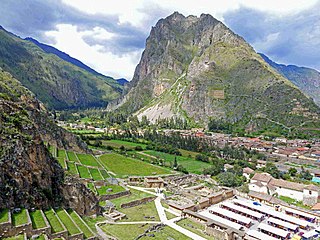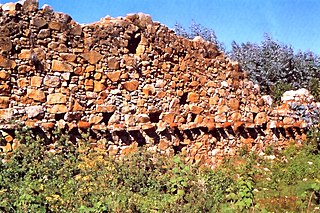
Machu Picchu is a 15th-century Inca citadel located in the Eastern Cordillera of southern Peru on a 2,430-meter (7,970 ft) mountain ridge. Often referred to as the "Lost City of the Incas", it is the most familiar icon of the Inca Empire. It is located in the Machupicchu District within Urubamba Province above the Sacred Valley, which is 80 kilometers (50 mi) northwest of Cusco. The Urubamba River flows past it, cutting through the Cordillera and creating a canyon with a tropical mountain climate. In reference to the site's name, for most English or Spanish speakers, the first 'c' in Picchu is silent. In English, the name is pronounced MAH-choo PEE-choo or MATCH-oo PEAK-choo, in Spanish as or, and in Quechua as.
Viracocha is the great creator deity in the pre-Inca and Inca mythology in the Andes region of South America. According to the myth Viracocha had human appearance and was generally considered as bearded. According to the myth he ordered the construction of Tiwanaku. It is also said that he was accompanied by men also referred to as Viracochas.

The Inca road system was the most extensive and advanced transportation system in pre-Columbian South America. It was about 40,000 kilometres (25,000 mi) long. The construction of the roads required a large expenditure of time and effort.

La Libertad is a department and region in northwestern Peru. Formerly it was known as the Department of La Libertad. It is bordered by the Lambayeque, Cajamarca and Amazonas regions on the north, the San Martín Region on the east, the Ancash and Huánuco regions on the south and the Pacific Ocean on the west. Its capital is Trujillo, which is the nation's third biggest city. The region's main port is Salaverry, one of Peru's largest ports. The name of the region is Spanish for "freedom" or "liberty"; it was named in honor of the Intendancy of Trujillo's proclaiming independence from Spain in 1820 and fighting for that. It is the ninth smallest department in Peru, but it is also its second-most populous department after Piura and its second-most densely populated department after Lambayeque.

Chan Chan, sometimes itself called Chimor, was the capital city of the Chimor kingdom. It was the largest city of the pre-Columbian era in South America. It is now an archeological site in the department of La Libertad five kilometers (3.1 mi) west of Trujillo, Peru.

The Chachapoyas, also called the "Warriors of the Clouds", was a culture of the Andes living in the cloud forests of the southern part of the Department of Amazonas of present-day Peru. The Inca Empire conquered their civilization shortly before the Spanish conquest in the 16th century. At the time of the arrival of the conquistadors, the Chachapoyas were one of the many nations ruled by the Incas, although their incorporation had been difficult due to their constant resistance to Inca troops.

Ollantaytambo is a town and an Inca archaeological site in southern Peru some 72 km (45 mi) by road northwest of the city of Cusco. It is located at an altitude of 2,792 m (9,160 ft) above sea level in the district of Ollantaytambo, province of Urubamba, Cusco region. During the Inca Empire, Ollantaytambo was the royal estate of Emperor Pachacuti, who conquered the region, and built the town and a ceremonial center. At the time of the Spanish conquest of Peru, it served as a stronghold for Manco Inca Yupanqui, leader of the Inca resistance. Located in the Sacred Valley of the Incas, it is now an important tourist attraction on account of its Inca ruins and its location en route to one of the most common starting points for the four-day, three-night hike known as the Inca Trail.

Kuélap or Cuélap is a walled settlement located in the mountains near the towns of María and Tingo, in the southern part of the region of Amazonas, Peru. It was built by the Chachapoyas culture in the 6th century AD on a ridge overlooking the Utcubamba Valley.

Peruvian architecture is the architecture carried out during any time in what is now Peru, and by Peruvian architects worldwide. Its diversity and long history spans from ancient Peru, the Inca Empire, Colonial Peru to the present day.

Huamachuco District is one of the districts of the Sánchez Carrión province located in La Libertad Region in Peru. It contains the capital of the province and the important archeological site of Marcahuamachuco, which was active, likely as an oracle center and place for religious and political elites, about 350 CE to 1100 CE.

The Sánchez Carrión Province, known until 1976 as Huamachuco Province, is one of twelve provinces of the La Libertad Region in Peru. It is named in honour of José Faustino Sánchez Carrión. The capital of this province is the city of Huamachuco. About 30 miles away is Marcahuamachuco, a prehistoric political and religious centre of a culture that throve AD 350-1100.

Huamachuco is a town in northern Peru and capital of the province Sánchez Carrión in La Libertad Region. The city is the seat of the Territorial Prelature of Huamachuco. Lake Sausacocha lies to the northeast.

Inti Punku or Intipunku is an archaeological site in the Cusco Region of Peru that was once a fortress of the sacred city, Machu Picchu. It is now also the name of the final section of the Incan Trail between the Sun Gate complex and the city of Machu Picchu. It was believed that the steps were a control gate for those who enter and exited the Sanctuary.

Viracochapampa, Huiracochapampa, or Wiracochapampa is an archaeological site with the remains of a building complex of ancient Peru of pre-Inca times. It was one of the administrative centers of the Wari culture. Viracochapampa is located about 3.5 km north of Huamachuco in the region of La Libertad at an elevation of 3,070 metres (10,072 ft).

Intihuatana is a ritual stone in South America associated with the astronomic clock or calendar of the Inca. Its name is derived from the local Quechua language. The most notable Intihuantana is an archaeological site located at Machu Picchu in the Sacred Valley near Machu Picchu, Peru. The name of the stone is derived from Quechua: inti means "sun", and wata- is the verb root "to tie, hitch (up)". The Quechua -na suffix derives nouns for tools or places. Hence inti watana is literally an instrument or place to "tie up the sun", often expressed in English as "The Hitching Post of the Sun".
Pirca Pirca is an archaeological site in Peru. It is located in the La Libertad Region, Bolívar Province, Uchumarca District. Pirca Pirca was declared a National Cultural Heritage of Peru by the National Institute of Culture by Resolución Directoral Nacional No. 075-INC on December 30, 1998. The site lies on top of the mountain named Pirca Pirca.
Alexei Vranich is an American archaeologist specializing in the pre-Columbian South America. His previous positions include Visiting Professor at the University of Warsaw, Poland (2021-22), Lecturer at the Department of Material Sciences at MIT (2021-22), Research Associate, and Assistant Dean at Bowles Hall Residential College (2016-18) at the University of California, Berkeley, Research Associate and Visiting Assistant Professor (2009-2015) at UCLA, and a Lecturer and Research Associate at the University of Pennsylvania from 1999 to 2004. He received his B.A. from the University of California, Berkeley in 1990 and his Ph.D. from the University of Pennsylvania in 1999. He is a Fulbright Scholar and Dumbarton Oaks Harvard Fellow. Vranich is presently teaching and conducting research at the University of Warsaw, Poland.
Nicola Masini is an Italian scientist with CNR, noted for his work on exploring traces of Andean civilizations in Peru and Bolivia using spatial technologies and Remote Sensing.

















